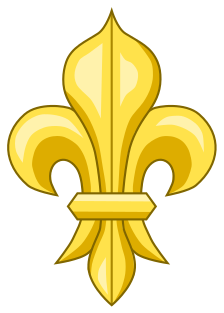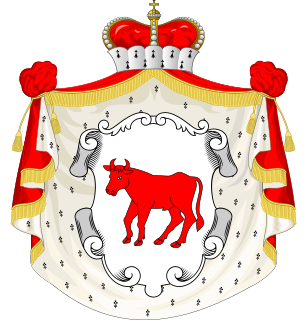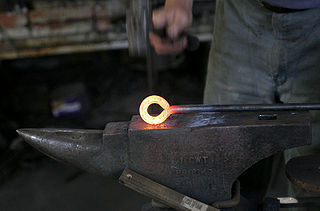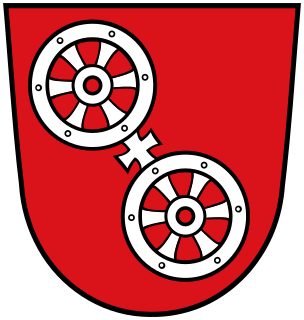
A coat of arms is a heraldic visual design on an escutcheon, surcoat, or tabard. The coat of arms on an escutcheon forms the central element of the full heraldic achievement which in its whole consists of shield, supporters, crest, and motto. A coat of arms is traditionally unique to an individual person, family, state, organization or corporation.

A motto is a maxim; a phrase meant to formally summarize the general motivation or intention of an individual, family, social group or organization. Mottos are usually found predominantly in written form, and may stem from long traditions of social foundations, or from significant events, such as a civil war or a revolution. A motto may be in any language, but Latin has been widely used, especially in the Western world.

The fleur-de-lis or fleur-de-lys is a stylized lily that is used as a decorative design or motif. Many of the Catholic saints of France, particularly St. Joseph, are depicted with a lily. Since France is a historically Catholic nation, the fleur-de-lis became "at one and the same time, religious, political, dynastic, artistic, emblematic, and symbolic", especially in French heraldry.

A crosier is a stylized staff carried by high-ranking Roman Catholic, Eastern Catholic, Eastern Orthodox, Oriental Orthodox, Anglican, and some Lutheran, United Methodist and Pentecostal prelates. Other typical insignia of many of these prelates are the mitre, the pectoral cross, and the episcopal ring. A crosier staff is a part of the tradition of Jewish Christianity.

The papal tiara is a crown that was worn by popes of the Catholic Church from as early as the 18th century to the mid-20th. It was last used by Pope Paul VI in 1963 and only at the beginning of his reign.

Dieu et mon droit, meaning "God and my right", is the motto of the Monarch of the United Kingdom outside Scotland. It appears on a scroll beneath the shield of the version of the coat of arms of the United Kingdom. The motto is said to have first been used by Richard I (1157–1199) as a battle cry and presumed to be a reference to his French ancestry and the divine right of the Monarch to govern. It was adopted as the royal motto of England by King Henry V (1386–1422) with the phrase "and my right" referring to his claim by descent to the French crown.

The wild man is a mythical figure that appears in the artwork and literature of medieval Europe, comparable to the satyr or faun type in classical mythology and to Silvanus, the Roman god of the woodlands.

Polish heraldry refers to the study of coats of arms in the lands of historical Poland. It focuses on specifically Polish traits of heraldry. The term is also used to refer to the Polish heraldic system, as opposed to systems used elsewhere, notably in Western Europe. As such, it is an integral part of the history of the szlachta, the nobility of Poland.

Ślepowron is a Polish coat of arms. It was used by several szlachta families in the times of the Polish–Lithuanian Commonwealth. From the fifteenth century, the descendants of the Ślepowron family began to use names taken from their lands. This led to many different surnames being created within one family. The Ślepowron coat of arms is unique in Polish heraldry, in that it is the only coat of arms which is indicative a common origin of individual families, that is, the de Ślepowron, or Korwin, family. Wawrzęta Korwin de Ślepowron is the oldest known ancestor of the family, although the family's oral traditions claim that they descend from Marcus Valerius Corvus, a Roman general.

Alpha and omega are the first and last letters of the Greek alphabet, and a title of Christ and God in the Book of Revelation. This pair of letters are used as Christian symbols, and are often combined with the Cross, Chi-rho, or other Christian symbols.

Korwin is a Polish coat of arms. It was used by several szlachta families in the times of the Polish-Lithuanian Commonwealth.

Poniatowski is a prominent Polish family that was part of the nobility of Poland. A member of this family, Stanisław Poniatowski, was elected as King of Poland and reigned from 1764 until his abdication in 1795. Since Polish adjectives have different forms for the genders, Poniatowska is the equivalent name for a female member of this family.

The Province of Genoa was a province in the Liguria region of Italy. Its capital is the city of Genoa. It was replaced by Metropolitan City of Genoa.

Smith is a surname originating in England. It is the most prevalent surname in the United Kingdom, Australia, Canada, New Zealand and the United States, and the fifth most common surname in the Republic of Ireland. The surname Smith is particularly prevalent among those of English, Scottish and Irish descent, but is also a common surname among African Americans, which can be attributed either to black slaves being given the surname during slavery and never changing the name upon the end of the era of slavery and after the issuance of the Emancipation Proclamation or to descendants of interracial marriages. 2,376,206 Americans shared the surname Smith during the 2000 census, and more than 500,000 people share it in the United Kingdom. At the turn of the 20th century, the surname was sufficiently prevalent in England to have prompted the statement: "Common to every village in England, north, south, east and west"; and sufficiently common on the (European) continent to be "common in most countries of Europe".

The personal papal coat of arms of Pope Benedict XVI was designed by Archbishop Andrea Cordero Lanza di Montezemolo soon after the papal election in 2005.
Polish names have two main elements: the imię, the first name, or given name; and the nazwisko, the last name, family name (surname).
Spencer is a surname, representing the court title dispenser, or steward. An early example is Robert d'Abbetot, who is listed as Robert le Dispenser, a tenant-in-chief of several counties, in the Domesday Book of 1086. In early times the surname was usually written as le Despenser, Dispenser or Despencer—notably in works such as the Domesday Book and the Scottish Ragman Rolls of 1291 and 1296, but gradually lost both the "le" article and the unstressed first syllable of the longer surname to become Spencer.

The Wheel of Mainz or Mainzer Rad, in German, was the coat of arms of the Archbishopric of Mainz and thus also of the Electorate of Mainz (Kurmainz), in Rhineland-Palatinate, Germany. It consists of a silver wheel with six spokes on a red background. The wheel can also be found in stonemasons' carvings and similar objects. Currently, the City of Mainz uses a double wheel connected by a silver cross.
A Lithuanian personal name, like in most European cultures, consists of two main elements: the given name followed by family name. The usage of personal names in Lithuania is generally governed by three major factors: civil law, canon law, and tradition. Lithuanian names always follow the rules of the Lithuanian language. Lithuanian male names, as well as the rest of words, have preserved the Indo-European masculine endings, although the rules are not as rigid as Latvian names, which preserve gendered endings even for foreign names.

Clan Ged is a Scottish clan. The clan does not currently have a chief recognised by the Lord Lyon King of Arms and is considered an armigerous clan. Without a recognised chief the clan has no standing under Scots Law. In Scotland, the surname Ged and Geddes may be derived from the place-name Geddes in Nairn. Another possibility is that it is derived from the Old English gedda, a nickname meaning pike. The coats of arms of Ged and Geddes contain three pike, referring to their surnames. The English word for pike is luce, and several Norman families named de Lucy have pike on their coats of arms. One unsupported possibility is that one such family moved to Scotland and adopted the surnames Ged or Geddes. An early record of the clan name is found in the Privy Council, which records the respite granted to James Tweedie after the murder of William Geddes in 1558.



















